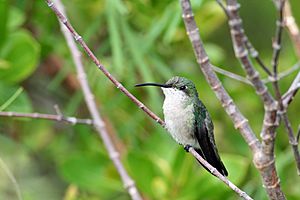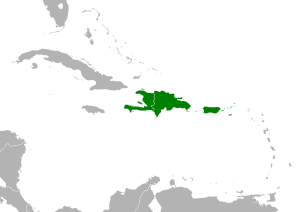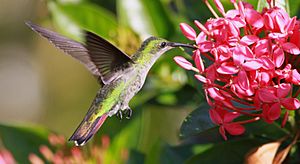Antillean mango facts for kids
Quick facts for kids Antillean mango |
|
|---|---|
 |
|
| Conservation status | |
| Scientific classification | |
| Genus: |
Anthracothorax
|
| Species: |
dominicus
|
 |
|
| Distribution | |
| Synonyms | |
|
Trochilus dominicus Linnaeus, 1766 |
|
The Antillean mango (Anthracothorax dominicus) is a type of hummingbird. It belongs to the hummingbird family, called Trochilidae.
You can find this bird on several Caribbean islands. These include Hispaniola (where the Dominican Republic and Haiti are), Puerto Rico, and the British Virgin Islands and U.S. Virgin Islands.
Contents
Classifying the Antillean Mango
A Swedish scientist named Carl Linnaeus first officially described the Antillean mango in 1766. He gave it the scientific name Trochilus dominicus in his book Systema Naturae. Linnaeus used information from a French zoologist, Mathurin Jacques Brisson, who had described this bird in 1760.
The first place where this bird was found and described was the Dominican Republic. This country is on the island of Hispaniola. Today, the Antillean mango is placed in the group, or genus, called Anthracothorax. A German zoologist named Friedrich Boie created this group in 1831.
Types of Antillean Mango
There are two main types, or subspecies, of the Antillean mango. Some scientists even think they might be different species:
- A. d. dominicus (Linnaeus, 1766) – This type lives on Hispaniola and nearby islands.
- A. d. aurulentus (Audebert & Vieillot, 1801) – This type is found in Puerto Rico, the Virgin Islands, and other nearby islands.
What Does the Antillean Mango Look Like?
Female Antillean mango hummingbirds and young birds have a white-gray chest. Adult females also have a tail that is a red-terracotta color. The tips of their tail feathers have small white spots.
Where Does the Antillean Mango Live?
The Antillean mango lives in several natural places, called habitats. These include dry forests in warm, tropical areas. They also live in moist lowland forests in tropical regions. You can also find them in areas where forests used to be, but have been changed a lot by humans.
How Does the Antillean Mango Behave?
This hummingbird is known for being quite quiet. It plays a very important role in nature. The Antillean mango is the main pollinator for two types of flowers: H. bihai and H. caribaea. This means it helps these plants make seeds by carrying pollen from one flower to another.



